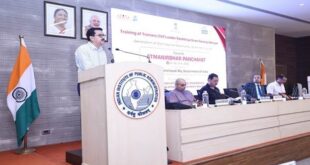- Recently, the Tamil Nadu government has decided to shun the usage of the term ‘Central government’ in its official communications and replace it with ‘Union government’.
- In common parlance, the terms “union government” and “central government” are used interchangeably in India. However, the Constituent Assembly did not use the term ‘Centre’ or ‘Central government’ in all of its 395 Articles in 22 Parts and eight Schedules in the original Constitution.
Important points:
- Article 1(1) of the Constitution of India says “India, that is Bharat, shall be a Union of States.”
- On 13th December, 1946, Jawaharlal Nehru introduced the aims and objectives of the Constituent Assembly by resolving that India shall be a Union of territories willing to join the “Independent Sovereign Republic”.
- The emphasis was on the consolidation and confluence of various provinces and territories to form a strong united country.
While submitting the draft Constitution in 1948, Dr B R Ambedkar, chairman of the drafting committee, had said that the committee had used the word ‘Union’ because:
- the Indian federation was not the result of an agreement by the units, and
- the component units had no freedom to secede from the federation.
The members of the Constituent Assembly were very cautious of not using the word ‘Centre’ or ‘Central government’ in the Constitution as they intended to keep away the tendency of centralising of powers in one unit.
Meaning
- According to constitution expert Subash Kashyap, from the point of the usage of the words, ‘centre’ indicates a point in the middle of a circle, whereas ‘Union’ is the whole circle.
- In India, the relationship between the so-called ‘Centre’ and States, as per the Constitution, is actually a relationship between the whole and its parts.
- Both the Union and the States are created by the Constitution, both derive their respective authority from the Constitution.
- The one is not subordinate to the other in its own field and the authority of one is to coordinate with that of the other.
- The judiciary is designed in the Constitution to ensure that the Supreme Court, the tallest court in the country, has no superintendence over the High Court.
- Though the Supreme Court has appellate jurisdiction, not only over High Courts but also over other courts and tribunals, they are not declared to be subordinate to it.
- In fact, the High Courts have wider powers to issue prerogative writs despite having the power of superintendence over the district and subordinate courts.
- In very common parlance, Union gives a sense of Federal while centre gives more of a sense of unitary government.
Way Forward
- The federal nature of the Constitution is its basic feature and cannot be altered, thus, the stakeholders wielding power intend to protect the federal feature of our Constitution.
- A diverse and large country like India requires a proper balance between the pillars of federalism, i.e. autonomy of states, national integration, centralisation, decentralisation, nationalisation, and regionalisation.
- Extreme political centralisation or chaotic political decentralisation can both lead to the weakening of Indian federalism.
- The satisfactory and lasting solution of the vexed problem is to be found not in the statute-book but in the conscience of men in power.
SOURCE: THE HINDU,THE ECONOMIC TIMES,MINT
 Chinmaya IAS Academy – Current Affairs Chinmaya IAS Academy – Current Affairs
Chinmaya IAS Academy – Current Affairs Chinmaya IAS Academy – Current Affairs



